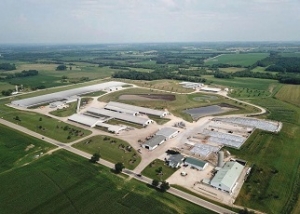Dairy in the World
Larson Acres Leans on Genomics to Make Genetic Progress

The decision was made to genomic test the heifer calves born from those purchased animals to determine how the future replacements fit into the farm’s genetic plan. Based on that experience, owner Mike Larson not only grew comfortable with the genomic process, but also became a believer in the data genomic testing provided.
“We see the results in the milking string,” Larson states. “Actual production correlates closely with genomic values.”
Now that the dairy is at maximum capacity, the Larson’s use genomics as part of a more comprehensive herd strategy on narrowing down not only which females they want to keep, but also addressing what resource needs should be allocated to those females.
Since the start the Larson’s have worked with Zoetis, who has helped the family navigate genomic testing. The one index that Larson leans into is Dairy Wellness Profit Index© (DWP$) with CLARIFIDE Plus.
“That's kind of the starting point of the conversation for us to figure out what resource needs to be allocated to which animals,” he shares.
DWP$ is a comprehensive animal ranking selection index with both cow and calf wellness traits.
Streamlining Sensor Technology
Larson believes that outside team members bring value to his dairy, such as the solid relationship he has with Zoetis, as well as CowManager and Select Sires. While he has worked with Zoetis and Select Sires for decades, he began using CowManager just last year and shares that he has already seen the benefits of improved reproduction, as well as finding sick cows sooner by utilizing sensor technology.
“It’s been advantageous for us,” he remarks. “It makes a lot of sense to pair genomic information with technology like CowManager to better monitor cows. It really works out well in the long run.”
While most of the breeding is conducted internally, the Larson’s also utilize help from an outside technician, who helps on OvSynch days. For heat detection, they use a double OvSynch program for first service animals and then employ CowManager to detect heats on repeats.
As an advanced genetic herd, Larson utilizes a significant amount of embryo technology. Half of their replacement heifers are recipients, and the other half are bred to sexed semen. In the adult herd, about half are bred to sexed semen, while the other half are either used for recipients or bred to either conventional semen or beef.
“About half of our lactation two and greater cows get bred to beef,” Larson adds.
Streamlining CLARIFIED Plus genomic data with CowManager dashboard will be extremely beneficial to the producer, says David Erf, dairy technical services geneticist with Zoetis.
“It gives you some clues as to where to go with what resources you should allocate to a particular cow,” he says.
Larson is excited to see the idea of having all of his herd’s genomic data coming together and being available on one dashboard. He says it gives a holistic approach to see if it’s worth investing all the labor and dollars into that cow. Erf says knowing a cow’s DWP$ from using CLARIFIDE Plus is crucial, as it helps provide direction for on-farm management decisions, like culling.
Larson states that the vision of an integrated dashboard in CowManager with genomic data from Zoetis would be beneficial to his dairy, as it could easily outline the make up on this herd. He shares that if a cow ranks in the bottom third and ends up with a DA, his employees know not to invest money into her.
“Let’s get all the information at our fingertips so we can make smart decisions,” he says.
Erf reminds us that no two herds have the same strategy with genomic management, and the good thing is no two herds need to. With genomic testing, you can identify your herd's best genetics, allowing you to determine what resources you want to allocate to which animal.
While higher feed prices might sway management decisions on the farm, Larson says he tries to remain consistent with a solid genomic plan.
“Overall, we try and look at the big picture, knowing we are not going to reap the rewards for a few years down the road,” he says. “So, we don’t try to make big changes, but readjusting as needed.”
Erf concurs with Larson, stating it is all about genetic progress. Stick to the initial plan even if you must recalibrate as needed to monitor genetic progress.
Genetic Improvement on the Farm
In Wisconsin, Larson says he sees progress when he looks out at his milking herd.
“We’ve been able to use the genetic information to make sure that the animals we want to keep are also going to be the profitable ones,” he says. “We want to make sure that the resources are spent correctly, meaning the top is flushed and the bottom half is used for recipients.”
Larson shares that before genomic testing, he was leery of selling animals because he feared he was going to sell a good one. With genomics, he says he can fine-tune his management by only calving in what he needs to maintain herd size and use the remainder as recipients for his flushing program.
The percentage of Larson’s herd that falls into third lactation and greater has increased from 30% 8 years ago to a 43% today. This is genetic progress that Larson was aiming for, as he likes an older herd.
“We want an older herd to take advantage of those high peaks you get from third lactations and greater,” he says. “But we also want to ensure that we are keeping the right type of animal.”
Larson says he is confident he would not be able to achieve this kind of progress, along with an overall healthier herd, without utilizing genomic testing.






















